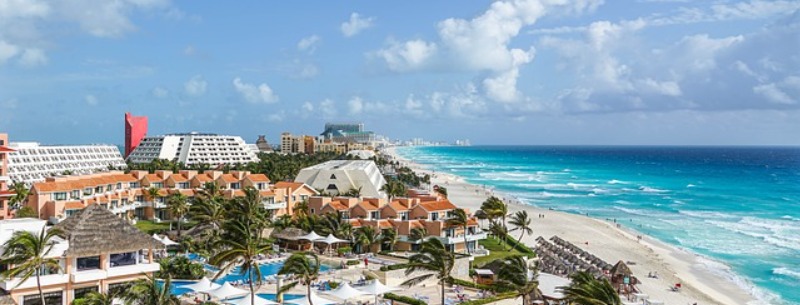Mexico Beach Guide 2024
A trip to Mexico is a popular choice for a variety of reasons. It is a country rich in ruins, culture, food, and, above all, beaches. In fact, beachgoers frequently find that the beaches are reason enough to visit Mexico on their own. Its extensive coastlines include the Gulf of Mexico, the Caribbean Sea, and the Pacific Ocean to the east and west, respectively.
If you want to see how stunning these Mexico beach destinations are, here’s a list of the best beaches in Mexico to help you plan your next beach vacation.
Akumal
Akumal is undoubtedly one of the most peaceful spots on the Riviera Maya. Just 37 kilometers from Playa del Carmen, this small village is a favorite with those who love isolation and peace and quiet.
It has grown considerably since it’s beginnings in the 1950’s as an exclusive resort for scuba divers, yet still maintains an unhurried, relaxed atmosphere. Akumal has escaped the hassles and hurries of most of the areas’ larger resorts.
In the Maya language, Akumal means “place of the turtles” and it is still one of their favorite places for laying their eggs. However what makes Akumal such a charming and fascinating destination for tourists from around the world is its spectacular protected bay area of transparent waters and the sweet water currents that flow through its caves and subterranean rivers.
Located North of Tulum, Akumal offers excellent hotel capacity as well as rental houses, condos, and restaurants specializing in local and international cuisine.
In Akumal are two hundred entrances to subterranean caves with depths of up to 150 meters, this is a favorite place for divers from around the world.
For the non-diver, the areas’ cenotes, bays, and lagoons all make the perfect place for an introduction to snorkeling. You will be amazed at the diversity of life you will see in these calm shallow waters.
Area dive shops offer instruction, equipment rentals and tours. All provide experienced knowledgeable staff that will see that your experiences are both rewarding and safe.
May through November is turtle nesting time in the Caribbean and Akumal is a major nesting site. Unfortunately turtles are shy animals and the growing numbers of people on the beaches at night with flashlights have reduced the number of successful nestings during the past few years.
Cancun
Hand-picked by computer, Cancun is, if nothing else, proof of Mexico’s remarkable ability to get things done in a hurry if the political will is there. A fishing village of 120 people as recently as 1970, it’s now a city with a resident population of half a million and receives almost two million visitors a year.
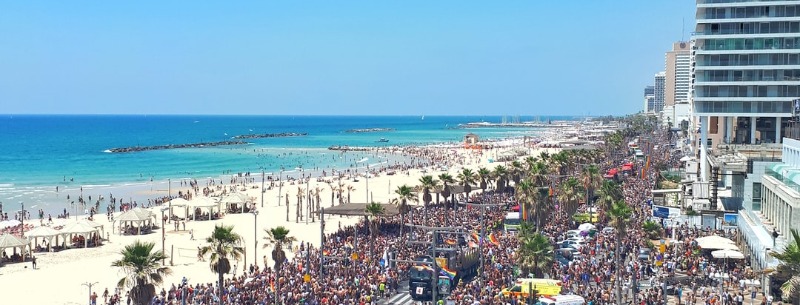
There’s little to see in downtown Cancun. Most visitors head straight for the zona hotelera and the beaches.
Though you’re free to go anywhere, and signposted public walkways lead down to the sea at regular intervals, some of the hotels do their best to make you feel like a trespasser, and staff will certainly move you off the beach furniture if you’re not a guest.
To avoid being eyed suspiciously by hotel heavies, head for one of the dozen or so public beaches: all are free but you may have to pay a small charge for showers.
Entertainment and expensive water sports are laid on all around the big hotels; if you venture further, where more sites await construction, you can find surprisingly empty sand and often small groups of nude sunbathers.
The best snorkelling in Cancun is at Punta Nizuc, next to Club Med territory.
You aren’t allowed to cross the grounds unless you’re staying there, so you have to get off the bus at the Westin Regina Resort, cross their grounds to the beach, then turn right and walk for about twenty minutes until you reach the rocky point. Walk across the rocks and snorkel to your heart’s content.
To join a snorkelling tour or go diving , contact Aqua Tours (tel 883-0440) or Aquaworld (tel 885-2288, www.aquaworld.com.mx ). A one-tank dive costs about US$50 and a full PADI open-water certification course around US$400.
To view the colourful underwater life in a more leisurely fashion, take a trip on the Sub See Explorer, a glass-bottomed boat that leaves from the Aqua World centre at Blvd Kukulkan Km 15.2 every hour from 9am until 3pm (US$35).
Both jet-skiing (US$50 for 30min) and parasailing (US$40 for 10min) are very popular in Cancun and operators are dotted at frequent intervals in front of the big hotels on the beach.
Cozumel
Cozumel is Mexico’s largest island and renowned mecca for divers. White, sandy beaches and alluring crystal waters are the perfect place to unwind and also offer an unforgettable underwater adventure.
Tall reefs line the southwest coast, creating towering walls that offer divers a fairy-tale landscape to explore.
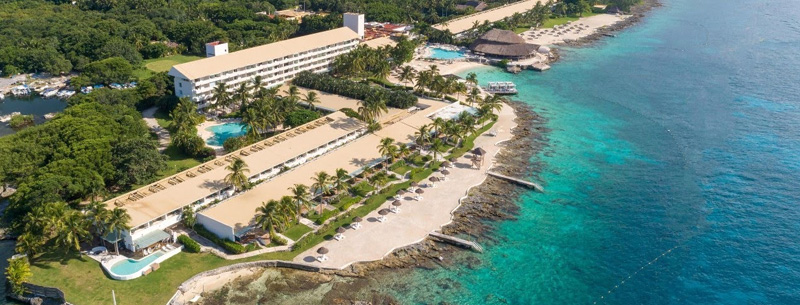
For non-divers, it has the beautiful water of the Caribbean with all the accompanying watersports and seaside activities. The island is 45km (28 miles) long and 18km (11 miles) wide, and lies 19km (12 miles) from the mainland. Most of the terrain is flat, undisturbed scrubland.
Along both the west and east sides of the island you’ll see signs advertising beach clubs. A “beach club” in Cozumel usually means a palapa hut that’s open to the public and serves soft drinks, beer, and fried fish.
Nachi Cocom, south of Chankanaab, even has a swimming pool, a good restaurant, and watersports equipment rental. A little farther south you’ll come to Playa San Francisco and, south of it, Playa Palancar.
Other beach clubs include Paradise Cafe, on the southern tip of the island across from Punta Sur nature park, and Playa Bonita, Chen Rнo, and Punta Morena, on the eastern side.
They are scattered along the coast and do a big business on Sunday, when the locals head for the beaches; otherwise they aren’t crowded. Most of the east coast is unsafe for swimming because of the surf.
Small beaches occupy the spaces between rocky promontories, and you can have one all to yourself.
If you’re not trying to get away from the crowds, there is an all-inclusive beach park, Playasol. It sells different packages for people wanting a day at the beach for $50 to $70, depending on the package. The park offers guests the use of a pool, restaurant, bar, and a number of watersports.
There is only one city on Cozumel, and it’s called San Miguel. The downtown and main square is a beautiful area with lovely shops for jewelry, T-shirts and exciting Mexican and Mayan decorations and souvenirs.
Avenida Rafael Melgar is the main waterfront street with a beautiful view of the ocean. The street is lined with shops of all kinds and there are several very striking monuments, including the Mayan statues and the divers arch.
Right across from the main square is the dock where you can catch a ferry to the mainland. The trip takes about 40-45 minutes, and the ferry takes you to Playa del Carmen. From there you can take a bus to Cancun, Tulum, Xcaret or other sites in the Yucatan.
Isla Mujeres
Isla Mujeres, just a couple of kilometers off the easternmost tip of Mexico in the startlingly clear Caribbean sea, is an infinitely more appealing prospect than Cancun.
Its attractions are simple: first there’s the beach, then there’s the sea. And when you’ve tired of those, you can rent a bike, moped or even golf cart to carry you around the island to more sea, more beaches, a coral reef and the tiny Maya temple that the conquistadors chanced upon, full of female figures, which gave the place its name.

Unfortunately, however, Mujeres is no longer the desert island you may have heard about, and its natural attractions have been recognized and developed considerably in the last few years.
There are now several large hotels and thousands of day-trippers from Cancun, and the once beautiful El Garrafon coral reef is now almost completely dead.
Inevitably, too, prices have risen and standards (in many cases) have fallen. All that said, it can still seem a respite to those who’ve been slogging their way down through Mexico and around the Yucatan – everyone you’ve met along the way seems to turn up here eventually.
Ixtapa and Zihuatanejo
Zihuatanejo is located in the state of Guerrero on the Pacific Coast of Mexico about 240km northwest of Acapulco. The modern tourist resort of Ixtapa is only 5km away.
Zihuatanejo has the old-fashioned charm of traditional Mexican culture. Fishing continues to be a way of life for a large number of families, and the increasing popularity of the area as a sportfishing destination has given new impetus to their livelihood.
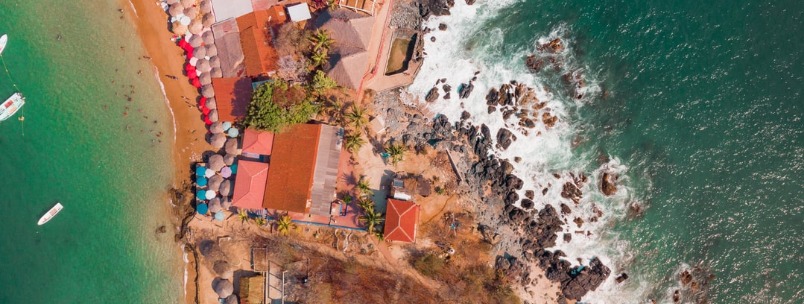
Ixtapa is not actually a town but rather is administered by a federal agency called FONATUR, entrusted with land sales and development as well as public administration and services for Ixtapa’s businesses, residents and visitors.
In Ixtapa there are several shopping centers with classy shops, boutiques, restaurants, bars and discotecs. High-rise hotels line most of the beach along with time-shares and condominiums.
Zihuatanejo’s main attraction is its well-protected bay where travelling boaters often spend the winter months moored in its peaceful clear waters. The bay offers various beaches for relaxation, recreation, dining, or simply enjoying the abundantly beautiful scenery and laid-back local lifestyle.
The main part of downtown Zihuatanejo is still rather old-fashioned with narrow streets made of paving-stones and where most people still walk to get around.
At Zihuatanejo’s town beach, Playa Municipal, the local fishermen pull their colorful boats up onto the sand, making for a fine photo op. Playa Madera, just east of Playa Municipal, is open to the surf but generally peaceful.
South of Playa Madera is Zihuatanejo’s largest and most beautiful beach, Playa La Ropa, a long sweep of sand with a great view of the sunset.
The nicest beach for swimming, and the best for children, is the secluded Playa Las Gatas, across the bay from Playa La Ropa and Zihuatanejo. The small coral reef just offshore is a nice spot for snorkeling and diving, and a little dive shop on the beach rents gear.
Ixtapa’s main beach, Playa Palmar, is a lovely white-sand arc on the edge of the Hotel Zone, with dramatic rock formations silhouetted in the sea. The surf can be rough; use caution, and don’t swim when a red flag is posted.
Several of the nicest beaches in the area are essentially closed to the public. Although by law all Mexican beaches are open to the public, it is common practice for hotels to create artificial barriers (such as rocks or dunes).
Club Med and Qualton Club have largely claimed Playa Quieta, on the mainland across from Isla Ixtapa.
Isla Ixtapa-bound boats now leave from the jetty on Playa Linda, about 13km north of Ixtapa. Playa Linda is the primary out-of-town beach, with watersports equipment and horse rentals available.
Playa las Cuatas, a pretty beach and cove a few miles north of Ixtapa, and Playa Majahua, an isolated beach just west of Zihuatanejo, are both being transformed into resort complexes.
All of these are very attractive beaches for sunbathing or a stroll but have heavy surf and strong undertow.
La Paz
Everyone ends up in La Paz eventually, if only to get the ferry out, and it seems that most of the population of Baja California Sur is gravitating here, too. The outskirts are an ugly sprawl, their development outpacing the spread of paved roads and facilities.
But the town centre, modernized as it is, has managed to preserve something of its quiet colonial atmosphere. You can stroll along the waterfront malecon, and for once the beach in town looks inviting enough to swim from – though there are no guarantees on the cleanliness of the water.
The best time to visit is from November to May, as summers can be unbearably hot. During the last week in February La Paz holds its carnival, with colourful parades and cultural events transforming the town.
There’s not a great deal to see in La Paz itself and if you’re staying for any length of time you should head for the beaches. If you’re just hanging around waiting for a ferry, however, you can happily fill a day window-shopping in the centre – hundreds of stores take advantage of the duty-free zone – and browsing around the market.
Beaches ring the bay all around La Paz, but the easiest to get to are undoubtedly those to the south, served by the local bus that runs along Obregon to the ferry terminal at Pichilingue.
Decent ones are Playa del Tesoro, shortly before Pichilingue, and Playa Pichilingue, just beyond the ferry station. Both have simple facilities, including a restaurant.
The best, however, is Playa de Balandra, actually several beaches around a saltwater lagoon with eight shallow bays, most of which are no more than waist deep: three buses daily leave the malecon from 10am and traverse the beach route, taking you here for US$3; the last bus back is 5pm.
There are plenty of opportunities for fishing and diving, and for boat trips into the bay; just stroll along the malecon to find people offering the latter – Isla Espiritu Santo is a popular destination, as is Los Islotes, where there’s a colony of sea-lions – or see Listings for details of specific operators.
Los Cabos
The highway between Cabo San Lucas and San Jose del Cabo gives access to a welter of superb beaches, many of them visible from the road.
Unfortunately, as development continues, access, especially for those on foot, is becoming increasingly difficult.
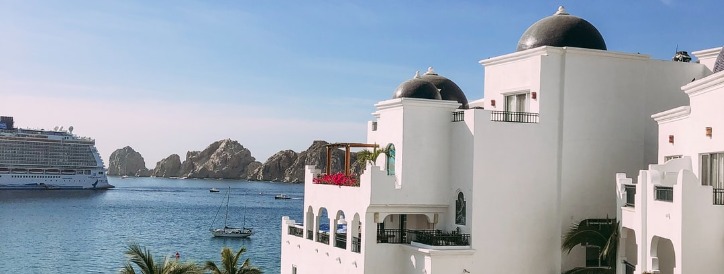
You could just ride along until you see one you fancy, but if you have a preference and are using the bus between the two towns, make sure the driver is prepared to let you off at your desired stop.
Apart from Solmar and Del Amor, all distances are measured east from Cabo San Lucas towards San Jose del Cabo, 33km away.
Solmar, 1km west. Pacific-side beach with strong undertow. Whale-watching Jan-April.
Del Amor, in centre. Boat-access beach spanning the two seas out by El Arco. Great snorkelling on the marina side.
Medano, 1km. Los Cabo’s beach. Sand, restaurants, bars and abundant aquatic paraphernalia to rent. Usually uncomfortably crowded.
Cemeterio, 4km. Beautiful swimming beach. Access on foot from Medano.
Barco Varada, 9km. Shipwreck beach. The remains of a Japanese trawler that sank in 1966 is the main diving focus. Surfing, rock reefs, too. Access very difficult.
Santa Maria, 12km. Scuba and snorkelling on rock reefs at both ends. Excellent swimming. Easy access, not far from road.
Punta Chileno, 14km. Underwater sports on rock and sand bottom. Excellent swimming and snorkelling. Easiest access of all.
Canta Mar, 16km. Appropriately dubbed “surfing beach”. Occasional point breaks.
Punta Palmilla, 27km. Good safe beach used by San Jose hotel residents needing escape from the strong rip closer to home. Point and reef breaks when surf’s up.
Costa Azul, 29km. Consistently the region’s best surf beach. Shore break but rocks at low tide.
La Playita, 2.5 km east of San Jose via a dirt road. Secluded and excellent for fishing; swimming is also possible, but look out for the plentiful surfers.
Mazatlan
A city with a population of nearly 500,000, Mazatlan is the largest port between Los Angeles and the Panama Canal. Elegant reminders of its history, 27km of sandy beaches, and a geographically diverse environment are all added attractions in Mazatlan’s efforts to become a premier beach resort.
Old Mazatlan, the area around the center of town is a great area to do some exploring. Many of the oldest buildings have been restored, or are in the process.

There are walking tours and city tours that will point out the highlights of The Historic Zone. Take a tour if you are so inclined but a casual exploratory walk is the really best way to discover the real charm and history of old Mazatlan.
The golden zone is the location of most of the tourist hotels, a lot of the finer restaurants and most of the local night life. The golden zone is anywhere north of Punta Sabalo, where one of the cities most recognizable city attractions is situated, Fiesta Land.
Fiesta Land is party headquarters in Mazatlan, a great place to start or end your search for the local hot spot. Most of the nightlife, hotels and attractions in the golden zone are within walking distance of each other.
Mazatlan has over 15 miles of pleasant beaches to enjoy. The most popular tourist beaches are located in golden zone, which is located north of Fiesta Land, the Moorish style complex that houses a great deal of Mazatlan’s hearty nightlife.
In the golden zone you will find many varieties of water sports, great beachfront restaurants, and many of Mazatlбns most popular hotels. One of the most popular areas seems to be the area around and between the Hotel Playa Mazatlan and Joe’s Oyster Bar.
Much of the beach action is really not in the sand or surf, but along the Malecon, which fronts the beaches. Each evening when the sun starts to set the Malecon springs to life.
At the western edge of downtown is rocky, pebbly Playa Olas Altas, a lovely stretch of pounding surf, but not suitable for swimming. Around a rocky promontory north of Olas Altas is Playa Norte, which offers several kilometers of good sand beach.
At the Sabalo traffic circle, Punta Camaron juts into the water, and on either side of the point is Playa Las Gaviotas.
Farther north, Playa Sabalo is perhaps the best beach in Mazatlan. The next point jutting into the water is Punta Sabalo, beyond which you’ll find a bridge over a channel that flows in and out of a lagoon.
Mazatlan is one of only a few resorts in Mexico where surfing is common on central town beaches. The waves are best at Los Pinos, north of the fort — known in surfing circles as “the Cannon” — and at Playa Los Gaviotas and Playa Los Sabalos.
A good beach that makes a great day trip is on the ocean side of Isla de la Piedra. From the center of town, board a Circunvalacion or Playa Sur bus from the north side of the Plaza Principal for the ride to the boat landing, Embarcadero-Isla de la Piedra.
Small motorboats make the 5-minute trip to the island every 15 minutes or so from 7am to 6pm for a modest price. When you arrive on the island, walk through the rustic little village to the ocean side, where the pale-sand beaches, bordered by coconut groves, stretch for miles.
On Sunday afternoons, the palapa restaurants on the shore have music and dancing, attracting mainly Mexican families; on other days the beach is almost empty.
Playa del Carmen
Playa del Carmen (known simply as Playa) once a soporific, very Mexican fishing village, has mushroomed in recent years and now has the dubious distinction of being the world’s fastest growing town (by a rate of 26 percent per annum), according to the Guinness Book of Records.
It’s expensive and overcrowded, not only with holiday-makers but also thousands of day-trippers from Cancun and passing Caribbean cruise ships.
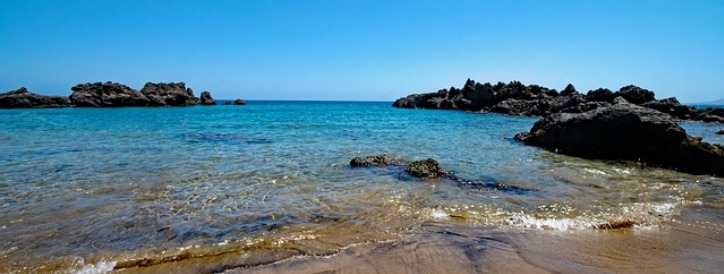
As a result the town’s main centre of activity, Av 5 (or Quinta), a long, pedestrianized strip one block back from the sea, is often packed to capacity with visitors rapidly emptying their wallets in pavement cafes, souvenir and silver-jewelery outlets and designer clothes shops.
Additionally, with the arrival of US fast-food giants McDonalds, Burger King and TFI Friday, Playa’s rather chic European atmosphere is giving way to a blander, more homogenized culture.
The beach, however, is one of the prettiest on the coast with unfeasibly white sand and gloriously clear sea and the entire town is, for the moment, still compact and easily covered on foot – as well as playing host to the best nightlife on the Riviera Maya.
The reef offshore is almost as spectacular here as in Cozumel and there are scores of professional scuba-diving operations in Playa – recommended is Tank-Ha, Av 5 between C 8 and 10 which offers PADI certification courses (US$350), one- and two-tank dives (US$45-65) and whole dive packages (from US$175) as well as twice-daily snorkeling tours (9.30am & 1.30pm; US$25; 3hr).
If you’re a real thrill-seeker, you can sky-dive from Playa with Sky-Dive Playa del Carmen, Plaza Marina, which comes in at US$200 for a tandem dive with a certified instructor.
Puerto Escondido
Puerto Escondido was established in 1928 as a port for shipping coffee. In the 1960’s it was connected to other coastal towns by Highway 200. Tourists began to discover the town and surfers found its beaches. Its importance as a port diminished as coffee shipments began going by truck instead of boat.

Puerto Escondido is without a doubt the most well protected anchorage on the Baja, and perhaps the entire Sea of Cortez. It is actually two anchorages; the outermost, known as the “Waiting Room”, is not as well protected as the innermost harbor, but is well suited to boats that are just passing through.
The Waiting Room is separated from the main harbor by a narrow, shallow channel. You cannot see just how large the harbor is until you have passed through this channel, hence the name Puerto Escondido, which means “Hidden Harbor”.
Playa Principal, where small boats are available for fishing and tour services, and Playa Marineros, adjacent to the town center on a deep bay, are the best swimming beaches.
Barter with one of the fishermen on the main beach for a ride to Playa Manzanillo and Puerto Angelito, two beaches separated by a rocky outcropping. Here, and at other small coves just west of town, swimming is safe and the overall pace is calmer than in town.
You’ll also find palapas, hammock rentals, and snorkeling equipment. The clear blue water is perfect for snorkeling. Local entrepreneurs cook fresh fish, tamales, and other Mexican dishes right at the beach.
Playa Bacocho is on a shallow cove farther northwest and is best reached by taxi or boat, rather than on foot. It’s also the location of Coco’s Beach Club at the Posada Real Hotel.
Also northwest of town is a pair of small beaches called Playa Carrizalillo. A small stream enters the ocean at the smaller beach and locals wash their clothes here. Good swimming, snorkeling, and scuba diving, lots of coral and fish. To get to these beaches, take highway 200 northwest for 1/2 mile, turn left at Avenida Miguel Hidalgo.
One of the world’s best surfing beaches is Playa Zicatela, especially during the months of July, August, and September. The 10-mile long beach has several restaurants and hotels. Due to the size and strength of the waves, it’s not a swimming beach, and only experienced surfers should attempt to ride Zicatela’s powerful waves.
A surfing competition in August and Fiesta Puerto Escondido, held for at least 3 days each November, celebrate Puerto Escondido’s renowned waves.
Past Zicatela to the east is Playa Barra de Colotepec extending 1-1/4 mile to Rio Colotepec. Heavy surf, dangerous for swimmers. Turtles lay their eggs at this long beach and volunteers from the Campamento Tortugas aid in their survival.
Puerto Vallarta
Puerto Vallarta‘s beaches vary in nature as you move round the bay: those to the north, out near Nuevo Vallarta and the airport, are long, flat stretches of sand often pounded by surprisingly heavy surf; south, a series of steep-sided coves shelter tiny, calm strands.
The town beach, Playa de los Muertos (Beach of the Dead), or “Playa del Sol” as the local tourist office would prefer it known, falls somewhere between the two extremes: not very large and reasonably calm, yet facing apparently open water.
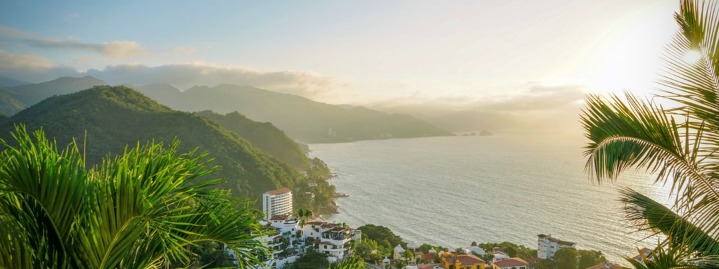
This is the most crowded of all, with locals, Mexican holiday-makers and foreign tourists, and in many ways it’s the most enjoyable – plenty of people and activities on offer, food and drink close at hand.
To the north , the best beaches tend to front the big hotels, but beyond Nuevo Vallarta, where the landscape becomes drier and scrubbier, there are some lovely, deserted stretches of sand, pounded by heavy surf. If you decide to swim here, don’t underestimate the strength of the undertow.
The smaller stretches of sand to the south are far more popular. There are small beaches every few hundred metres, difficult to get to unless you’re staying at one of the hotels or condos that back them, while 9km out of town is a bungee jumping operation.
If you’re after peace and quiet, the best option is continue along the highway from El Eden for another 4km until you reach the sleepy village of Boca de Tomatlan, which has a small but beautiful beach in a protected cove, dotted with fishing boats.
The local specialty, cooked to perfection by the beachside enramadas, is pescado de bara; a fish impaled on a stick and slow-cooked over a barbecue. The Rio Horcones, with its thickly forested banks, empties into the sea beside the beach, so there’s a choice of fresh – or saltwater for swimming.
The best-known and most convenient beach is Mismaloya, some 10km out of Puerto Vallarta. Here John Huston filmed The Night of the Iguana , building his film set on the southern side of a gorgeous bay at the mouth of what was once a pristine, jungle-choked gorge.
Crowded with sun-worshippers and enthusiastic vendors selling everything from coconuts to sarongs, Mismaloya is not a beach on which to relax. You can still wander out to the point and the ruins of the film set where a couple of expensive restaurants sell beer and seafood cocktails.
Boats are on hand to take you snorkeling at Los Arcos, a federal underwater park and “eco-preserve” around a group of offshore islands, some formed into the eponymous arches. A superb array of brightly colored fish – parrot, angel, pencil, croaker and scores of others – negotiate the rock walls and the boulder-strewn ocean floor 5m below.
Rosarito
If you want to escape the pace and noise of Tijuana, head for Rosarito, about 45-minutes’ bus ride on the old road to Ensenada.
Since beaches in Tijuana are invariably crowded and dirty, Rosarito, is the better alternative as, while scarcely less popular, the town has a far longer, sandier strand and a much more restful atmosphere.
It’s not particularly attractive – the beach is grey, windswept, and none too clean, lined with condo developments and hotels – but it does make for a worthwhile afternoon.
To get to Rosarito from Tijuana, take one of the colectivo taxis that leave from Madero between 4th and 5th, or head for the old bus station at Madero and 1st, from where buses leave every hour or so; to get back , just flag down a bus or colectivo on Juarez, Rosarito’s main street.
There are few budget hotels, among them the Motel Sonia (US$10-15) at Juarez and Plama, but a better option is the Hotel California (US$15-25).
Right on the beach with ocean views is the Hotel Los Pelicanos (US$40-60), by the large terracotta-colored hotel block.
The style and charm that made the upscale Rosarito Beach Hotel (US$60-80) a Hollywood favorite during the Prohibition years has now largely been obliterated by modern refurbishment, but the older rooms still have some character.
Along the single street behind the beach is a row of restaurants, cafes and bars, some of them pretty good, in particular the fish restaurants and a couple of cafes that serve decent cappuccino and cakes.
The party-time focus is Papas and Beer, where beach volleyball and knocking back as much Corona as possible is the order of the day.
Tulum
Tulum is located on Mexico’s Yucatan peninsula, close to Cancun and Isla Mujeres. Golden sands and clear blue waters of the Caribbean make it a perfect spot for pleasure seeking beach lovers.
The beach is also a stunning backdrop for the ruins of the ancient city of Tulum, built by the Mayans between the 11th and 15th centuries.

Tulum means ‘wall’, a name given to the site relatively recently because there is a wall surrounding it. In ancient times it was known as Zama, meaning the City of the Dawn.
The Mayan civilization was already in decline when the city was founded, yet it remained inhabited until after the Spanish conquest. The ruins, which include a watch tower looking out over the Caribbean, several elaborate temples and a Great Palace, are open daily.
Some of the biggest powder beaches on the coast are in Tulum. There is a nice small beach right in the famous Tulum ruins, but the best are just south, along the road to Boca Paila. That’s the same road that goes to the Sian Kaan Biosphere and Punta Allen (at the bitter end). To get there take the Coba road east (sign for Boca Paila) and then bear right on the coastal road (south).
There is also great beach the other way (north, toward the ruins). Beach access is generally through the cabana resorts you will be passing.
Most visitors to Tulum are happy to spend their days lying on the beach but if you’re looking for something more energetic to do, the Cenote Dive Centre, close to the turn-off for Coba, organizes cavern snorkeling tours as well as PADI scuba-diving and specialized cave diving course.
On the other side of the road, Sian Ka’an Tours has a variety of tours into the Sian Ka’an reserve.
The nearby Restaurante Crocodilo takes reservations for horse rides to the Maya ruins at Muyil.
Because the accommodation in Tulum is spread over 10km and the village is 2km from the beach, almost every hotel in the place has its own restaurant – fittingly they range from cheap and grungy right through to very chic indeed – and guests tend to stick to these.
Still, there are several other places to eat along the coast road worth making a trip to: Gringo Daves, 3km from the ruins, which serves delicious fish and grilled meat in a lovely clifftop setting; and Que Fresco, at the Zamas hotel, a very good Italian restaurant with a wood-fired pizza oven and fresh pasta.
